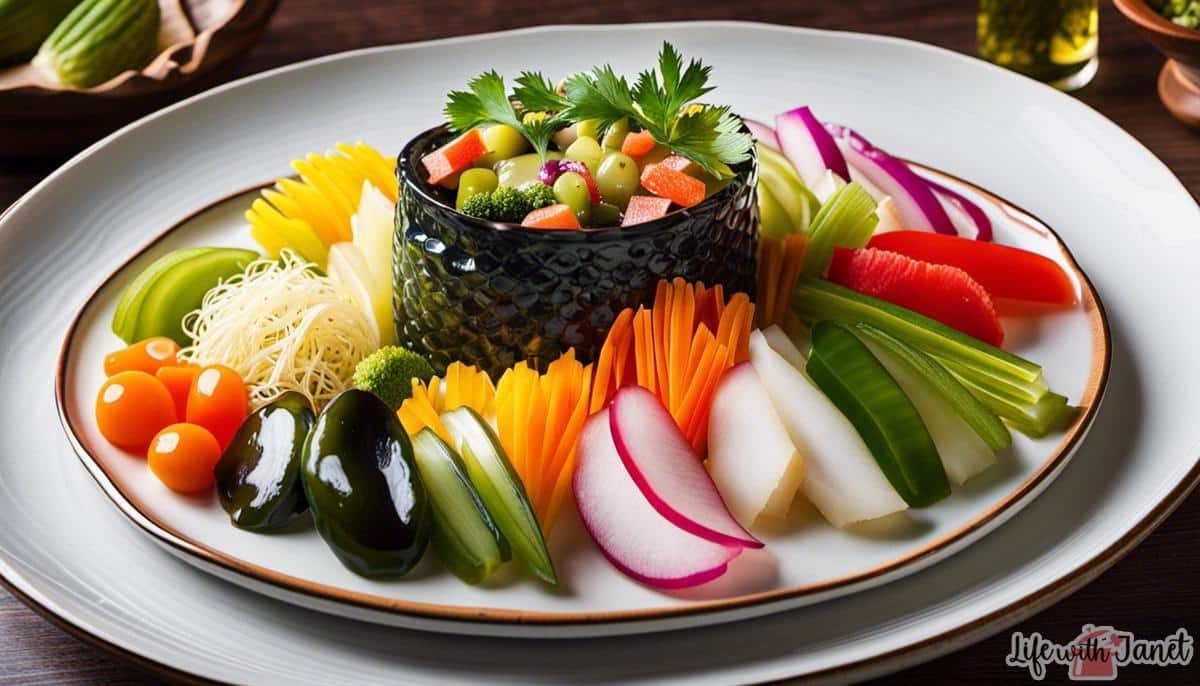WANT TO SAVE THIS RECIPE?
Bringing a symphony of crunch, tangy flavor, and a brilliance of yellow to the palate is the Japanese culinary gem known as Oshinko. A staple food dating back centuries, Oshinko is deeply entrenched in the annals of Japanese culinary history and culture. Derived from a traditional pickling process, this accompaniment is now relished globally, not only for its unique flavor profile and versatility but also for its host of health benefits. From its historical depths to its role in contemporary cuisine, and a closer look at its health prowess, Oshinko serves a tale as colorful and complex as its flavor. For anyone keen on immersing themselves in different cultures through food, learning about Oshinko is a journey worth undertaking.
Origins and Historical Significance of Oshinko
Origins of Oshinko
Oshinko, a term that literally translates to “honored fermented thing”, is a variety of Japanese pickle. The practice of pickling vegetables arose during the Heian period in Japan, between 794 and 1185 AD, to preserve food and prevent spoilage. By the 17th century, during the Edo period, pickling had evolved into an art, with regional varieties across Japan developing unique processes and flavors.
The term ‘oshinko’ did not appear until the early 20th century. It was originally coined to refer to a new type of Japanese pickle that had been fermented for less time than traditional tsukemono, or pickled foods, resulting in a crunchier texture and fresher taste. Today, the term is broadly used to refer to any type of pickles served in a Japanese meal, including those that have been fermented for an extended period of time.
Historical Significance of Oshinko
Oshinko holds immense cultural importance in Japanese food history. Pickles have been a part of Japanese dietary culture for centuries, originally owing to their preservative qualities. They allowed people to store and consume their harvests year-round, helping to sustain communities during the long, harsh winters.
Moreover, oshinko serves a unique role in complementing Japanese cuisine. They clear the palate, making each bite and each dish distinct. Given the delicate and nuanced flavors found in many traditional Japanese meals, this makes oshinko an essential part of the dining experience.
The different types of oshinko, made from various fruits and vegetables, and each region’s unique methods of pickling, also reflect the diversity of Japanese food culture.
Understanding the Traditional Preparation of Oshinko
Oshinko, a Japanese specialty, is a type of pickled vegetable dish traditionally prepared with a special brine. The brine typically comprises a combination of salt, vinegar, and sometimes additional flavor enhancing ingredients like soy sauce or miso. The choice and proportion of ingredients play a critical role in defining the flavor and texture of the final pickles.
What sets oshinko apart is its comparatively brief or partial pickling process, which could span from a few hours to a few weeks depending on the desired flavor and texture. Such a short fermentation period means the vegetables maintain their natural color and crispness – a feature that differentiates them from other Japanese pickles that undergo longer fermentation.
The art of preparing oshinko varies regionally and even individually. While in some regions of Japan, the vegetables are merely seasoned with salt and left to release their natural juices, in others, they are immersed in a mixture of rice bran and chili peppers to derive a distinctive taste. This variability results in an array of oshinko varieties, each boasting unique tastes and textures.

Oshinko in Modern Cuisine
Incorporation of Oshinko into Modern Global Cuisine
As a celebrated piece of traditional Japanese gastronomy, oshinko has successfully endeared itself to modern international food culture. Essentially, oshinko is a collection of pickles made from a variety of vegetables, notably radish, cabbage, and cucumber. These vegetables undergo fermentation in salt, rice bran, or sake lees, producing a dish that is primarily served as an accompaniment but can also be integrated into a broad spectrum of dishes for an additional zing of flavor.
Oshinko’s Popularity in Sushi Rolls
One of the areas where oshinko has gained widespread popularity is in the realm of sushi. In many sushi rolls, especially those of the vegetarian variety, oshinko plays a pivotal role as an important ingredient. Despite its simplicity, the pickled radish known as oshinko adds an essential crunch and unique tanginess to sushi rolls that cuts through the richness of the rice and seaweed. Also, its vibrant color adds aesthetic appeal, making the dish more enticing.
International Recognition of Oshinko
Oshinko has not just found its way into traditional Japanese sushi, but it has crossed cultural boundaries to be recognized and used internationally. It has found a place in the culinary practices of many countries, enhancing the flavor profiles of various cuisines. From being integrated in salads in European cuisine for its refreshing taste, to being incorporated in Asian fusion dishes due to its ability to enhance flavors, the global culinary community has embraced oshinko.
Oshinko’s Health Benefits
In addition to its unique taste, oshinko’s popularity in the food world is also influenced by its health benefits. This pickled dish is known for promoting gut health, aiding digestion, and being rich in vitamins and minerals. Plus, it’s low in calories, which aligns well with the modern focus on health-conscious eating.
Introduction to Oshinko
Oshinko is steadily gaining recognition in contemporary culinary scene, thanks largely to its flexible flavor profile and connotations of cultural fusion. As curiosity in global gastronomy amplifies, preparation and items like oshinko have begun to resonate with food enthusiasts for their distinctive tastes and wellness benefits. Oshinko does more than just diversify gastronomic experiences; it is a tangible illustration of the intertwining of food, culture, and history in our progressively globalized society.

Health Benefits and Nutritional value of Oshinko
Oshinko and Its Probiotic Advantages
Often used to denote a variety of pickled vegetables within the Japanese cuisine, Oshinko is a potent source of beneficial probiotics. Such a healthy bacterial profile comes from its unique fermentation process. Fermentation, a traditional preservation method that triggers the conversion of food starches and sugars into lactic acid through beneficial bacteria and yeasts, supplies Oshinko with an abundance of probiotics. These live bacteria, predominantly lactic acid-producing ones, significantly contribute to personal health and well-being, with a strong influence on gut health. Incorporating Oshinko into your nutrition plan can help expand the population of useful gut bacteria, thereby enhancing digestion and optimising nutrient absorption.
Oshinko and Gut Health
The gut-benefiting properties of Oshinko are primarily due to the probiotics it contains. The human gut houses a complex ecosystem of microbes that aid in the digestion process, boost the immune system, and even contribute to mood regulation. Consuming foods rich in probiotics, like Oshinko, can help balance the gut microbiome by increasing the number of healthy bacteria. This process promotes optimal digestion, mitigates the instances of gut-related issues like constipation or diarrhea, and can even alleviate symptoms of certain chronic disorders such as inflammatory bowel disease (IBD) and irritable bowel syndrome (IBS).
Nutritional Value of Oshinko
Typically made from daikon radish, cucumber, or Napa cabbage, Oshinko boasts a low-calorie count and contains a modest amount of essential nutrients. For example, daikon radish, a common ingredient in Oshinko, is rich in vitamin C, which aids in boosting immune health. It also contains potassium, which helps in maintaining heart health, and other beneficial compounds like folate and magnesium. Always low in fat and cholesterol, Oshinko can fit comfortably in a variety of dietary regimens.
Other Potential Health Benefits of Oshinko
In addition to gut health and nutritional perks, Oshinko might offer several other health benefits due to the antioxidants it contains. Antioxidants work to protect the body from damage by harmful molecules known as free radicals. Eating Oshinko, therefore, could help decrease the risk of developing chronic diseases like cancer, heart disease, and type 2 diabetes. Moreover, dieticians and health professionals link probiotic-rich foods, such as Oshinko, to weight loss and enhanced weight management due to their ability in supporting metabolism and calorie regulation.
Furthermore, the fermentation process used in creating Oshinko may also result in other health-promoting substances. For instance, during fermentation, bacteria can produce short-chain fatty acids, which can contribute to improved digestive health, amongst other benefits.
Oshinko is a significant part of a well-rounded diet, yet it is important to note that overindulgence might lead to elevated sodium levels, given its pickling process. Thus, it’s critical to moderate your consumption if you want to reap the benefits without any potential drawbacks.

Preparing Homemade Oshinko
Understanding Oshinko
In Japan, the term Oshinko refers to pickled vegetables, or what we simply call pickles in English. These tangy, fermented veggies are a staple in many Japanese dishes, providing a delightful crunch and tangy zing that enhances flavor. Daikon radish, cucumber, napa cabbage, and eggplant are often used in Oshinko, all of which are pickled in a special brine solution. This solution is made up of salt, vinegar, sugar, and occasionally soy sauce or sake.
How to Prepare Homemade Oshinko?
In order to make Oshinko at home, you first need to select your preferred vegetable. Daikon, a type of white radish, is a popular choice as it holds up well to pickling and provides a pleasing crunch. Once you’ve decided on your vegetable, it should be cut into the desired shape and size – thin slices or matchstick pieces are common options.
The next step involves preparing the pickling brine. For a basic brine, you’ll need a mixture of water, salt, and sugar. Optional additions include vinegar for an extra tang, or rice wine (sake) for depth of flavor. Spices such as dried chili peppers can also be added for heat.
After the brine has been prepared, the sliced vegetables are added to the solution in a jar, ensuring that they are entirely submerged in the brine. These pickles should then be stored in a cool, dark place for a few days to a week, depending on preference, until the vegetables have fully fermented and absorbed the flavors from the brine.
Recipes Incorporating Oshinko
Oshinko can serve as an accompaniment to a number of dishes. They are a staple in traditional Japanese breakfasts and also popularly consumed with rice and miso soup.
One of the most well-known uses of Oshinko is in sushi, specifically Oshinko Rolls, also known as pickle rolls. Prepared using sushi rice, nori (seaweed) sheet, and Oshinko, these rolls are relatively simple to make and offer a unique combination of flavors.
Another dish revolves around Oshinko is Oshinko Salad. This refreshing salad combines Oshinko with other vegetables like cucumber and cabbage, along with a dressing made from soy sauce, rice vinegar, and sesame oil. It’s light, healthy and extremely flavorsome.
Also, Oshinko can be chopped up fine and added to fried rice or stir-fries for a pop of brightness. The tangy, crunchiness of the pickles adds a unique twist to these otherwise familiar dishes.

While the story of Oshinko unraveled, what appeared evidently is its enduring significance in Japanese culture and our global culinary ethos. From a humble side dish to a key component of sushi rolls, its vibrant color, invigorating taste and health benefits have earned a spot on the global food stage. Journeying from the cultural realms of Japan to your kitchen, this enlightening guide on Oshinko certainly empowers one to incorporate this golden-hued delight into their meals. So, embrace the joy of creating homemade Oshinko, relish its unique flavor, and embody the rich culinary heritage it represents.







